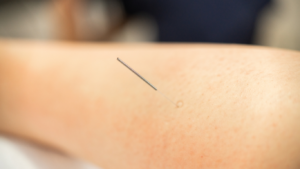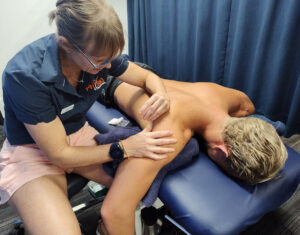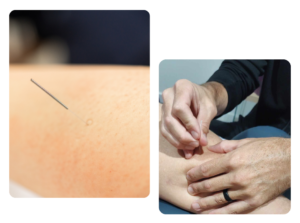DRY NEEDLING – WHAT IS IT, HOW DOES IT WORK & IS IT FOR ME ?
 What is Dry Needling ?
What is Dry Needling ?
Myofascial Dry Needling is a relatively new and extremely successful method used in the treatment of painful Myofascial Trigger Points or “knots”. It involves the insertion of an acupuncture style, small, sterile, solid, disposable needle into those painful trigger points which in turn elicits the bodies natural healing response in those tissues.
What is a Myofascial Trigger Point ?
A myofascial trigger point is a hyperirritable spot in a muscle which if often painful to touch and is located in a taught or tight band of muscle. This hypersensitive spot or ‘knot’ can give characteristic local pain, referred pain, referred tenderness, and other referred symptoms in areas other than where that muscle is located. These trigger points typically occur as a result of neuromuscular dysfunction and in areas of musculoskeletal stress.
 How does Dry Needling Work ?
How does Dry Needling Work ?
When appropriately stimulated, the body’s nervous system natural response is to begin a chain of reactions to aid healing. Dry Needling aims to augment this process. Despite being extremely narrow placing a needle into a skeletal muscle can disrupt up to 1000 muscle fibres. This disruption causes a normal physiological reaction by the body to repair the damaged tissue.
This process stimulates the immune, endocrine and cardiovascular systems and involves the release of endorphins, pain relief and increased blood supply to the affected area which in turn can help relax the affected muscle fibres.
Is Dry Needling similar to Acupuncture ?
Whilst there are obvious similarities in the two modalities there are also fundamental differences. Acupuncture treatment is based on the Traditional Chinese Medicine paradigm and involves placing needles into acupoints.
These acuponts are found along the meridians or channels and is aimed at restoring harmony, balance and the flow of Qi (life force) through these channels. Acupuncture is more subtle, gentle and more commonly used to treat internal ailments such as digestive issues, stress, insomnia, sub-fertility or in cases of chronic or ongoing pain.
 Is needling painful ?
Is needling painful ?
Most patients do not feel the insertion of the needle. Sometime an initial local twitch response is triggered which can be painful but is extremely brief. A localise ‘dull ache’ or cramp like sensation can also be felt around the insertion site and some local soreness can be felt after treatment.
What are the advantages of Dry Needling ?
The advantage of dry needling over other manual techniques is that we can treat parts of the muscle and deeper layers of muscle which our hands and fingers cannot always reach. Needles can also act as a ‘spare pair of hands’ allowing your therapist to work on more areas during your treatment, potentially increasing positive outcomes.
Who performs Dry Needling ?
At Gold Coast Physio & Sports Health a number of our Physios and Massage Therapists are qualified to offer Myofascial Dry Needling; if you are interested just ask our front desk staff and they will recommend an appropriate therapist to introduce you to the technique.
For appointments at Ashmore or Burleigh book online or call us on 07 5500 6470

































